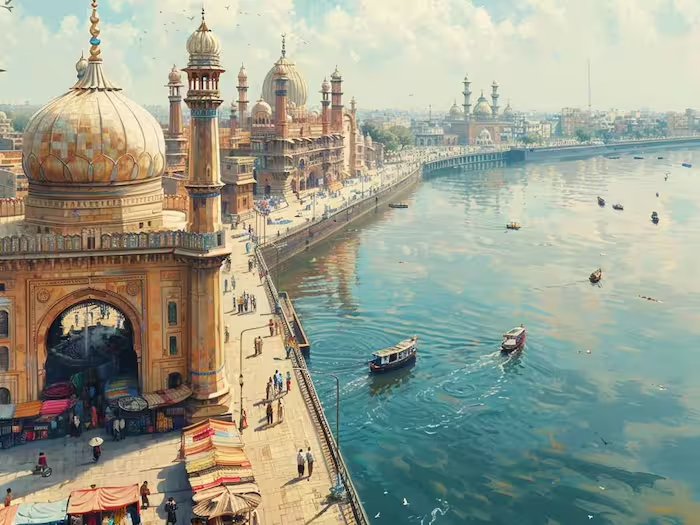Nine Must-See Tourist Destinations in Ahmedabad
Ahmedabad, which was established in 1411 AD, skillfully blends 600 years of rich history with contemporary conveniences to provide something for every kind of visitor, including ashrams that are tranquil, busy bazaars, beautiful lakes, and prestigious museums. You simply cannot afford to miss the top 9 sites of India’s first UNESCO World Heritage Cities, which are detailed in this guide.

1. Visit Sabarmati Ashram to Find Inner Calm
This humble ashram, which is situated on the serene banks of the Sabarmati River, was Mahatma Gandhi’s headquarters throughout the Indian independence movement, from 1917 to 1930. Inside his thought-provoking living quarters, one may view his trademark round glasses, walking stick, charkha for spinning thread, and other personal things. His principles of love, peace, and harmony among everyone are reflected throughout the ashram.
Principal feature: Magan Niwas, Gandhi’s lodging
Hours of the museum: 8:30 am to 6:30 pm
There is no admission charge
Remember to peruse the library’s vast 50,000-book collection for further in-depth understanding of Bapu’s philosophy of life.
2. Visit Bhadra Fort to Soak in History
Bhadra Fort, constructed by Sultan Ahmed Shah in 1411 AD next to the eastern bank of the Sabarmati River, captures the tumultuous history of India’s succession of rulers, from the Maratha Holkars to the Mughals and, eventually, the British. Stroll around its towering stone walls, which are adorned with several gates, palaces, royal tombs, mosques, and a temple that features a fusion of Islamic and Hindu architectural traditions.
Highlight of the day: the Royal Palace Museum
Fort hours: 9 a.m. to 5:30 p.m., except Thursdays
No entry costs
After your tour, plan up an hour to see internal cultural events like plays and folk dances.
3. Admire Sidi Saiyyed Mosque’s Detailed Stone Jalis
Considered a masterpiece of Indo-Islamic architecture, the Sidi Saiyyed Mosque was constructed in 1573 and draws large audiences with its exquisite interiors, pillars inlaid with red sandstone and marble, and five arches with carved stone trellis work. The work of art, however, is its renowned jharokhas or jalis on the western wall, which portray the elaborate “Tree of Life” and are said to symbolize the Islamic concept of One God supporting the whole cosmos.
Built by: Sultan Ahmed Shah’s slave, Sidi Saiyyad
Highlight: Ahmedabad’s unofficial emblem, the stone tree jalis
There is no admission charge
Before you take that iconic photo there, take a moment to admire the exquisite jaali artistry.
4. Savor Kankaria Lake’s Lakeside Views
Constructed in 1451, the picturesque Kankaria Lake provides a verdant haven among the concrete jungle of Ahmedabad. The tranquil 34-sided lake has parks, playgrounds, cafés, a zoo, a toy train, and even a tethered hot air balloon for views from above! It is also peppered with little islands! The week-long Kankaria Carnival in December, which includes dancing fountain displays, fireworks, and cultural events, attracts large audiences.
Primary feature: Hot Air Balloon Adventure
Regular admission: Rs. 20 per individual
Hours: 11 a.m.–8 pm, except Mondays
Choose from jet skiing, paddle boarding, toy train rides, or simply strolling around the edge to take in the peace and quiet of the lake as the sun sets.
5. Take a picture of Adalaj’s stepwell
About five centuries ago, the Adalaj Stepwell, which is 18 kilometers from Ahmedabad, was a hub for communal gatherings and a magnificent example of Indo-Islamic construction. You reach the increasing volume of water contained within the five-story-deep stepwell by descending via carved stone stairs. Each story is connected by intricately carved pillars and octagonal landings that are visible from underground and keep cool despite Ahmedabad’s scorching environment.
Rudabai constructed it in 1499.
Highlight: Islamic architectural elements combined with Hindu and Jain designs
There is no admission charge
Adalaj Vav is a photographers paradise! Try varying the angles and frames to get that Instagram-worthy picture.
6. Explore the History of Textiles at Calico Museum
Visit the unique Calico Museum, which was built utilizing Ahmed Shah’s royal harem, to learn more about India’s rich textile history! Distributed acrossSarkej Roza, the magnificent mausoleum and pleasure garden of Ahmed Shah is yet another magnificent example of Ahmedabad’s Islamic architectural legacy, skillfully fusing Persian and Indian traditions. Following the death of his adored wife in 1561, Sultan Mahmud Begada constructed this two-story building, which has multiple rooms, lattice windows, finely carved jalis, and domes. There are meandering walks, fountains, and flower beds in the four gardens that make up the geometric garden pattern designed in the Charbagh style.
Highlights: Jalis’s artistry and stonework
Sultan Mahmud Begada constructed it.
Admission fee: Rs 20. Spread over two galleries, this textile museum showcases more than 200 of the best textiles, garments, handicrafts, and other items from the 15th century forward, charting India’s 700-year textile history.
Founder of the museum: Gautam Sarabhai
The focal point is Resham Khana’s 17th-century velvets.
About 44,000 textiles and 6,000 books are on display, roughly.
Free entry, but reservations required in advance
When you see the painstaking craftsmanship involved in weaving those exquisite voiles and brocades, you will have a newfound admiration for India’s craftspeople.
7. Enjoy yourself at The Grand Mosque of Jama
One of Gujarat’s most striking mosques, the Jama Masjid, was constructed in 1423 and is modeled after the magnificent mosque in Mecca. Here, devotees perform namaaz five times a day. Admire its architecture, which combines Hindu and Jain-Hindu architectural features with Islamic domes, pillars, and jalis. The yellow sandstone edifice was carved by more than a thousand artisans. You may see the combination with Hindu and Jain temple-style sculptures at the main entrance itself.
The main attraction is the intricate Islamic prayer architecture and pillars.
Constructed by: Ahmed Shah
There is no admission charge Remember to stop in the middle and take in the breathtaking view of the soaring dome and intricate sculptures by looking up.
8. Bargain Hard in the Marketplace Manek Chowk
Manek Chowk, which dates back to the fifteenth century, is the cultural center of Ahmedabad. During the day, the bustling vegetable market has eighty vendors selling an abundance of fresh fruits and vegetables. Manek Chowk becomes a bustling street food hub at night, serving up delectable street cuisine like as basundi and doodhi na muthiya squash dumplings, along with delicious Bhathiya chicken.
Market specialization: shopping for vegetables, textiles, and gold
Highlights nearby include the Ghantakarna Mahavir Jain temple and the historic Jama Masjid.
Hours: 11 a.m.–2:30 p.m. and 6 p.m.–midnight
To get the greatest bargains on spices, fabrics, and traditional clothing, don’t forget to indulge your bargaining instincts.
Take a Vintage Tour at the World Auto Museum
Experience a captivating journey through time at India’s first vintage vehicle museum, featuring more than 175 pristine historic cars from 1933 onwards. Discover the incredible history behind India’s first Rolls Royce Carrian and a 1935 Rolls Royce Phantom that was formerly owned by the Maharaja of Orccha. You’ll be in complete awe. In addition, there are classic motorcycles, rare automobiles, a 1948 Cadillac that was driven by India’s first president, and a Daimler that was featured in Bollywood films.
Founder of the museum: Pranlal Bhogilal
Categories: Automobiles, bicycles, carriages, limos, and more
Fees for entry: Rs 120 per person
Location: Close to the railway crossing Shreyas
Car enthusiasts might easily gorge on these vintage beauties for two hours in this ultimate car paradise.
Ahmedabad offers famous attractions including culture, history, architecture, spirituality, adventure, and cuisine to suit any traveler’s taste, whether it via cutting edge museums, historic hotels, or outdoor adventures! However, you should make time for these nine events throughout your vacation here to fully appreciate its remarkably variegated character, which skillfully blends tradition with global citizenship.







